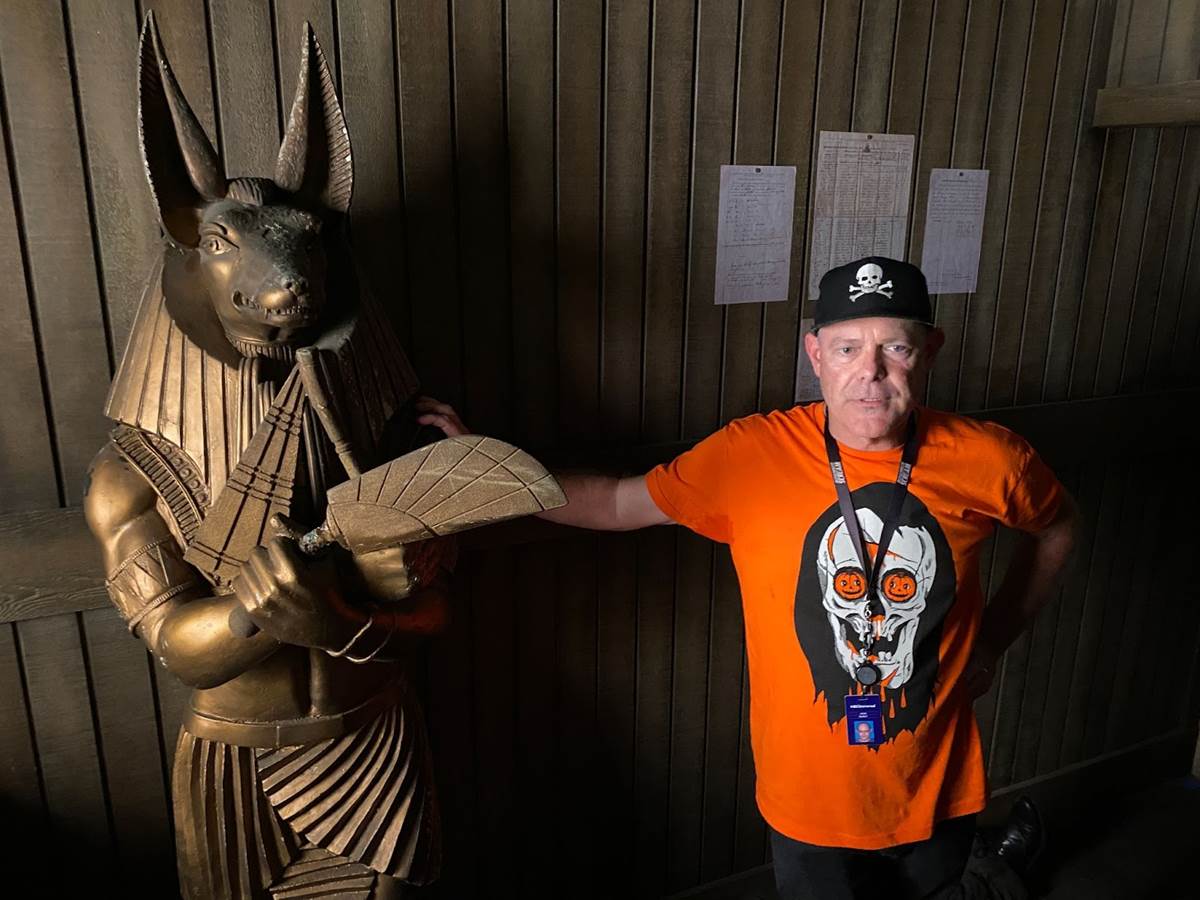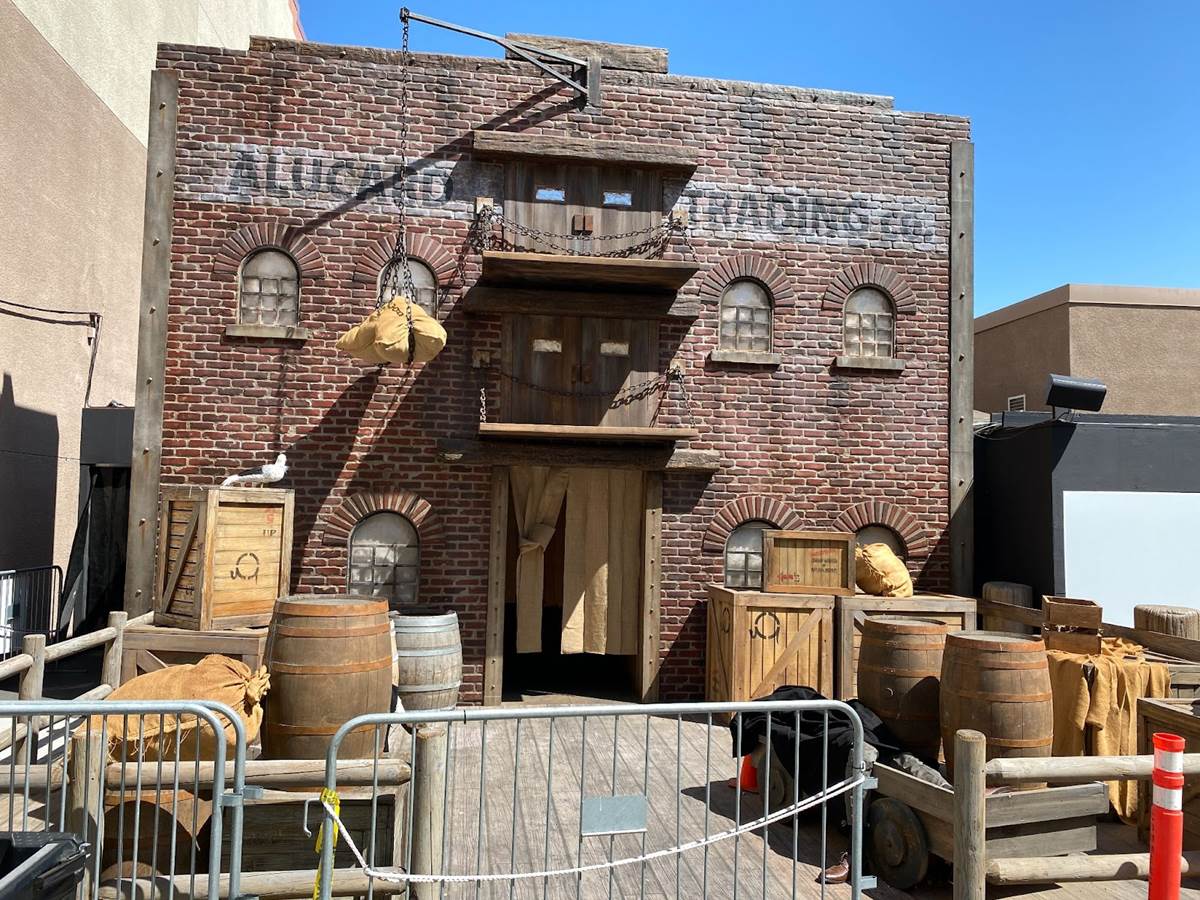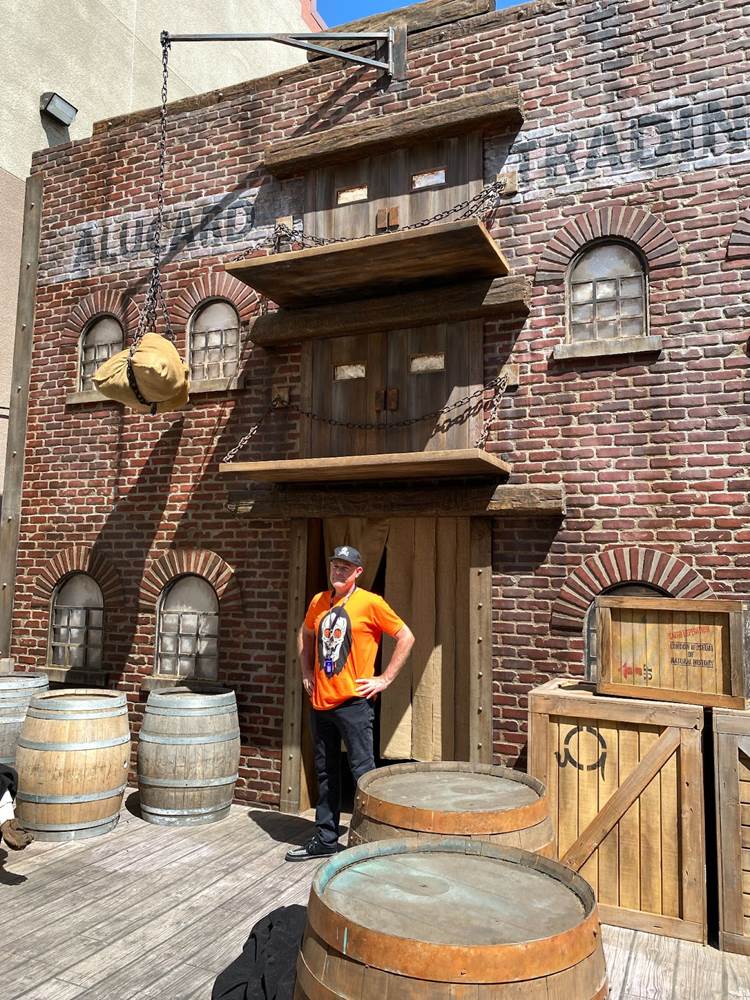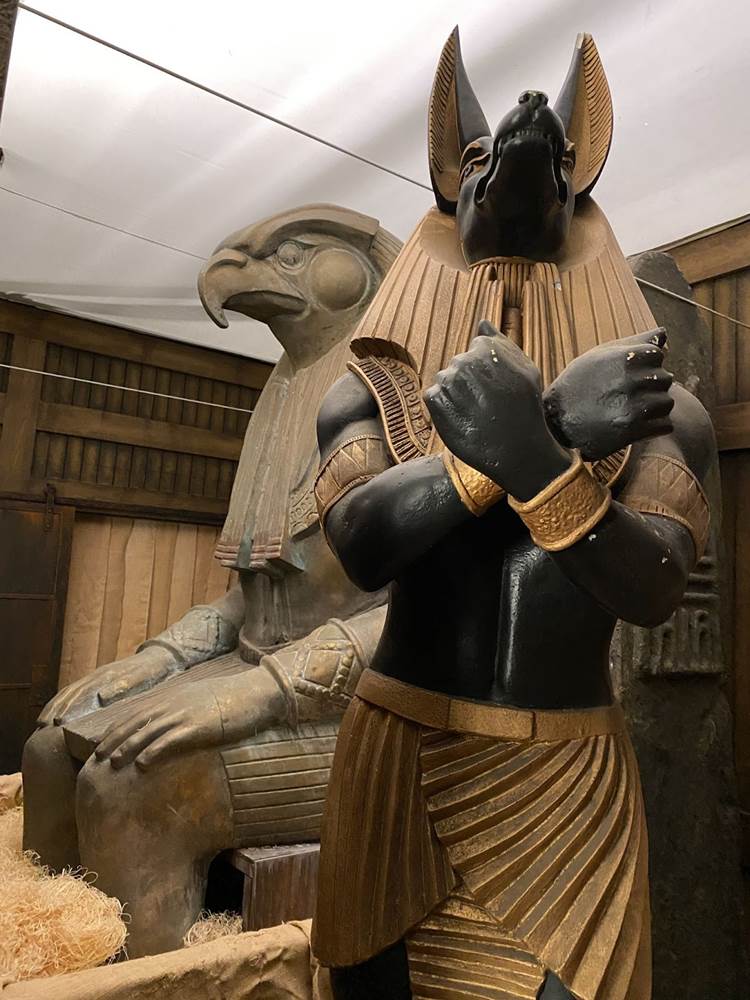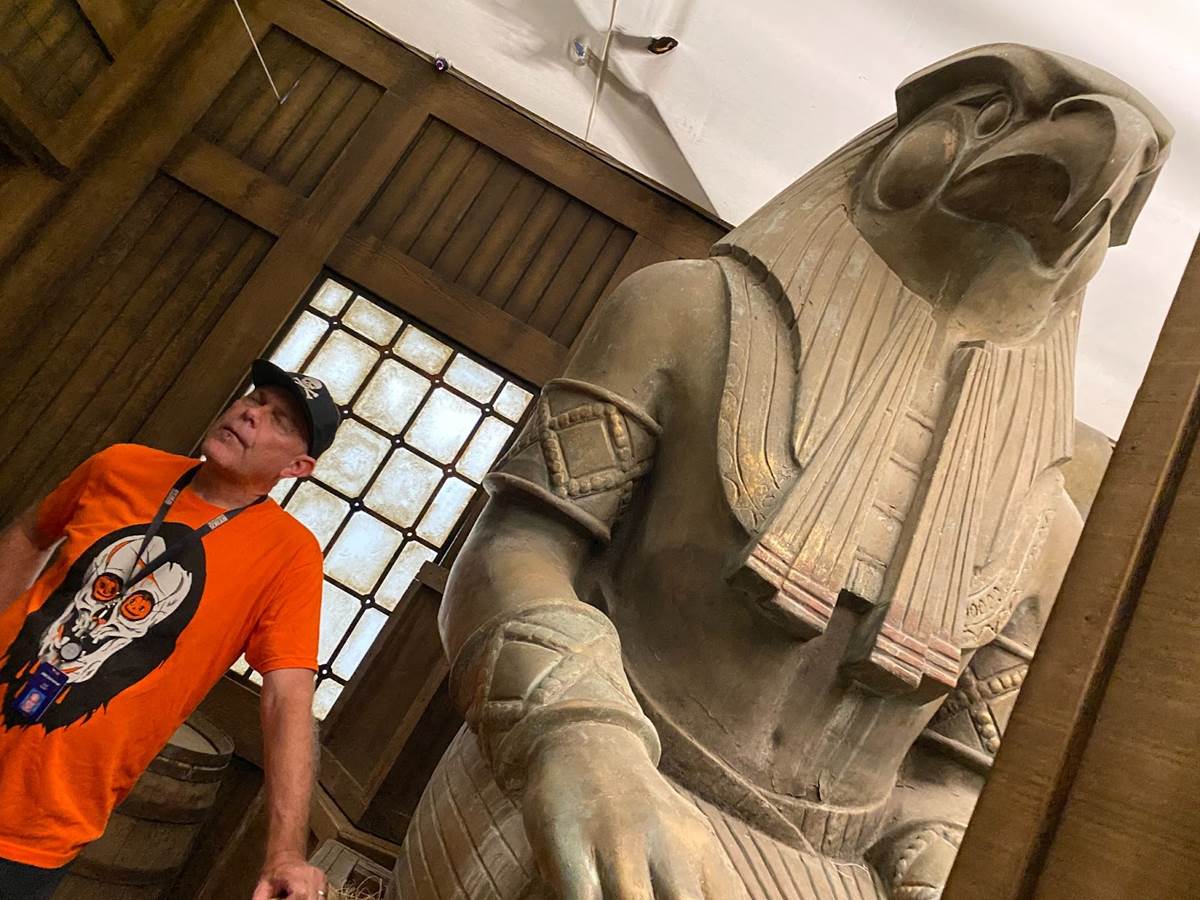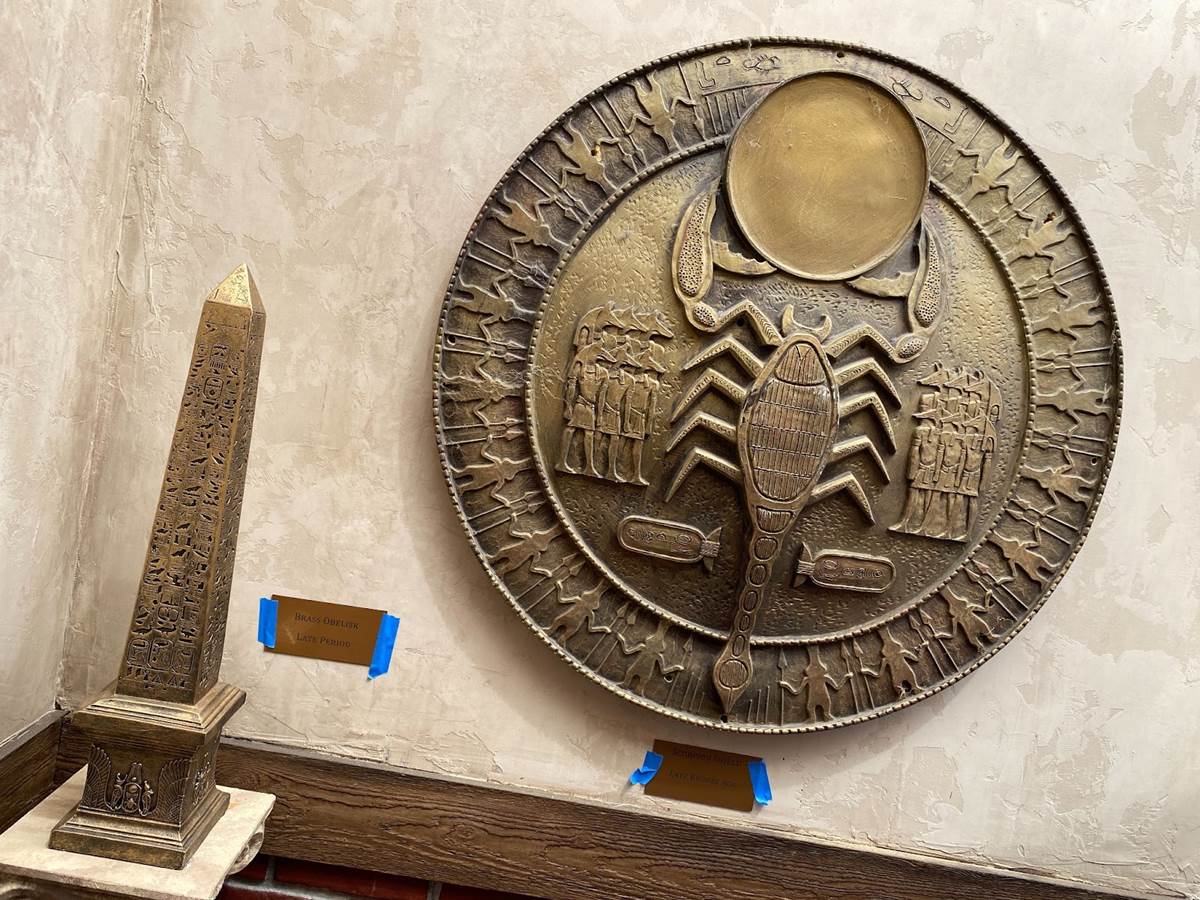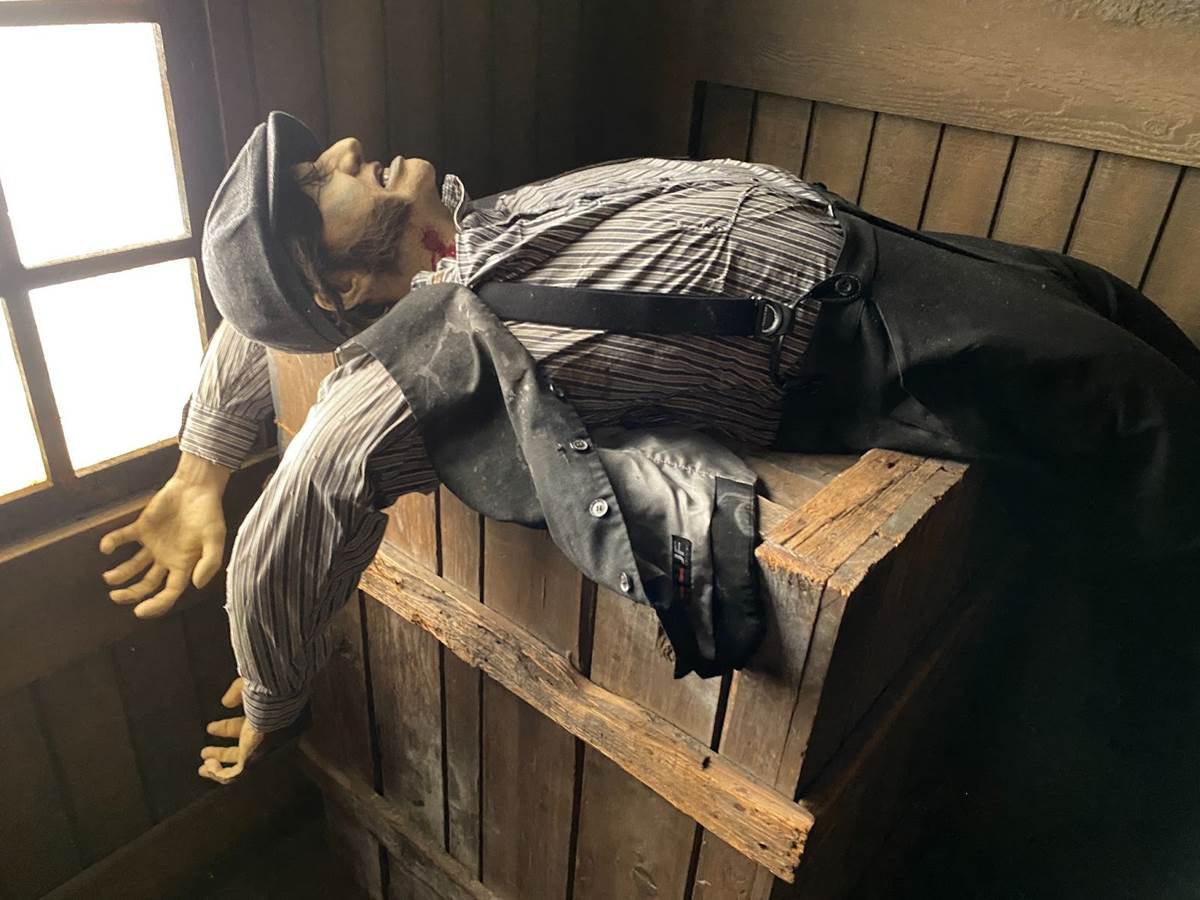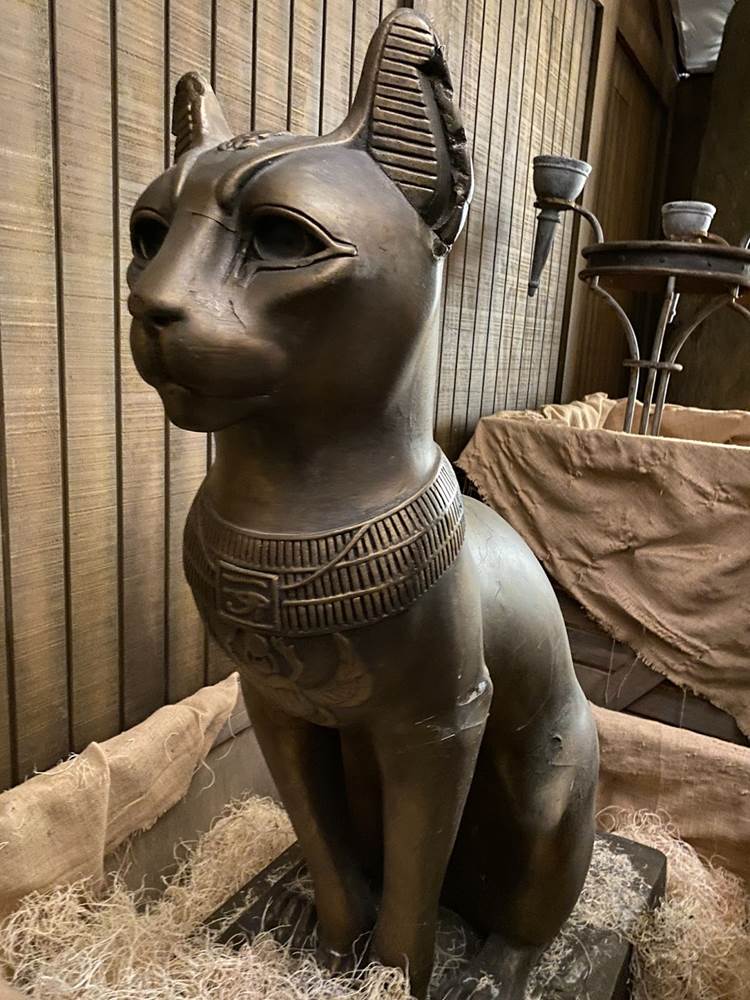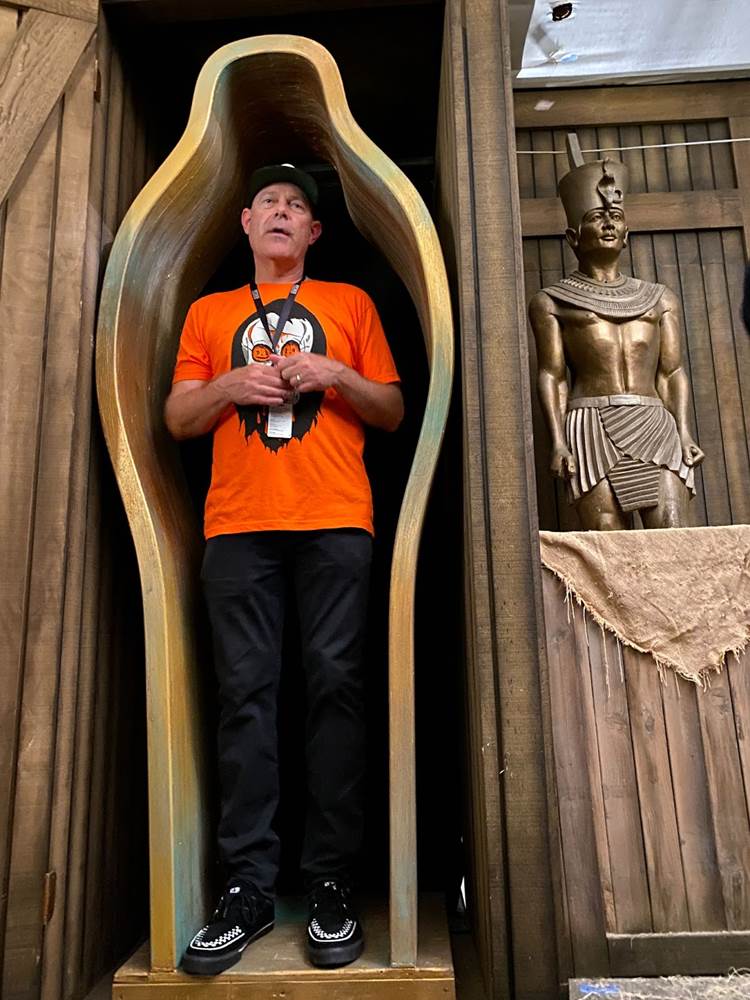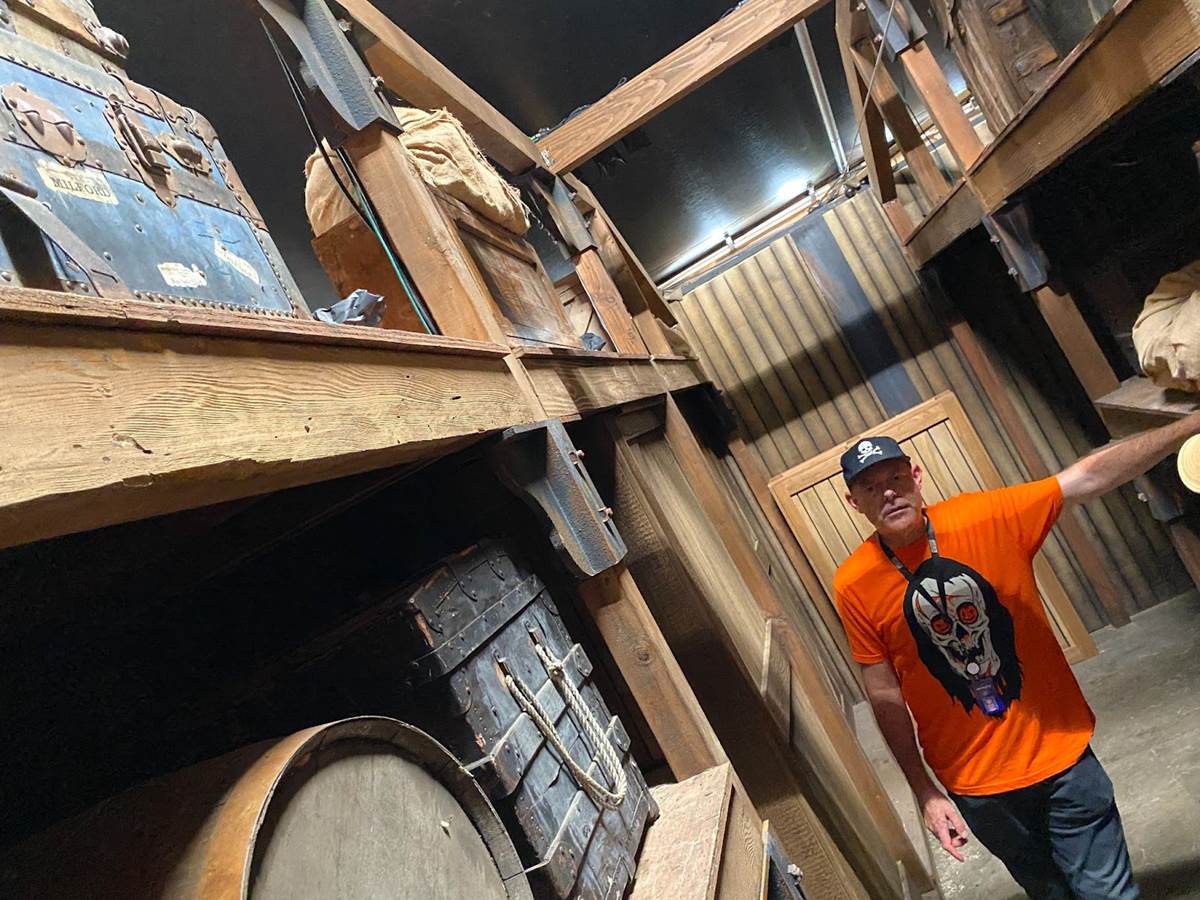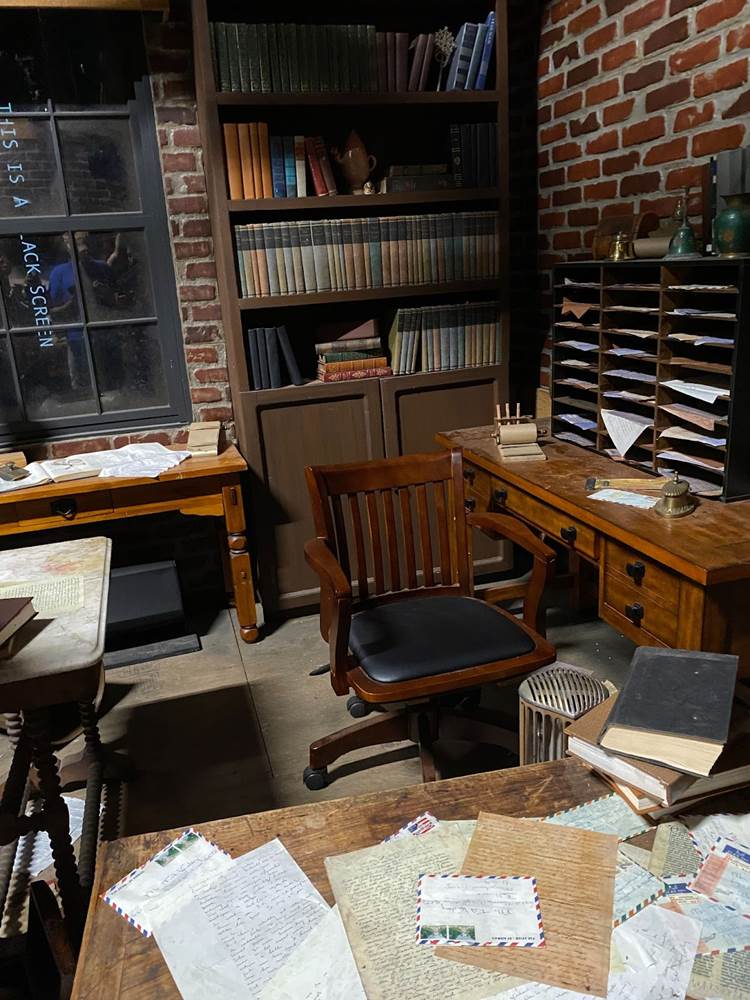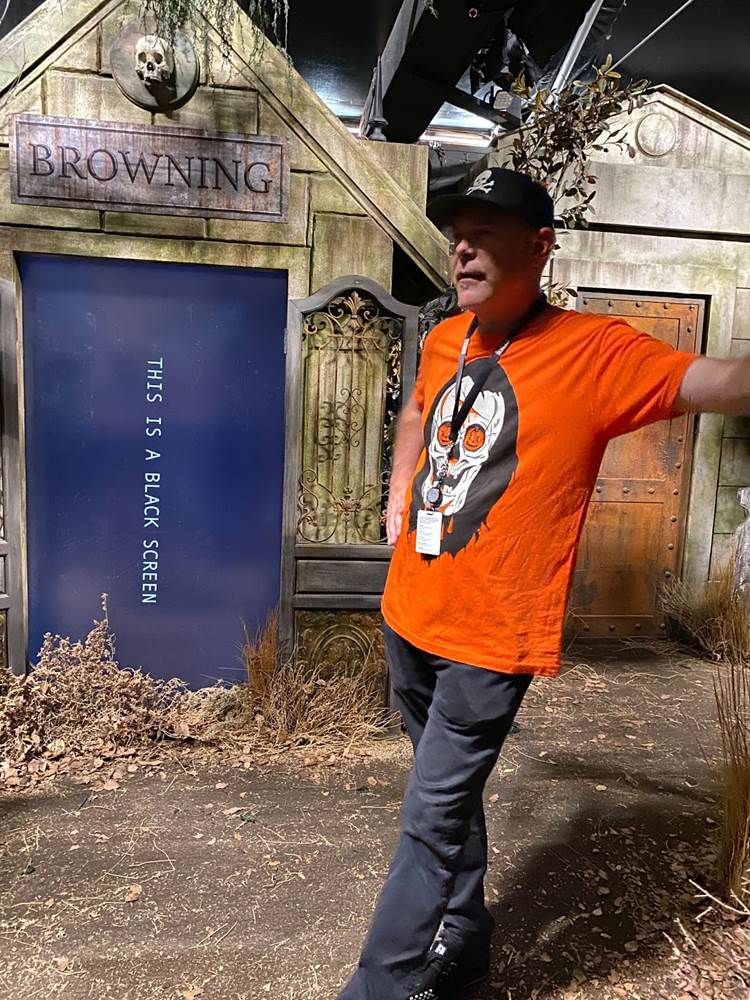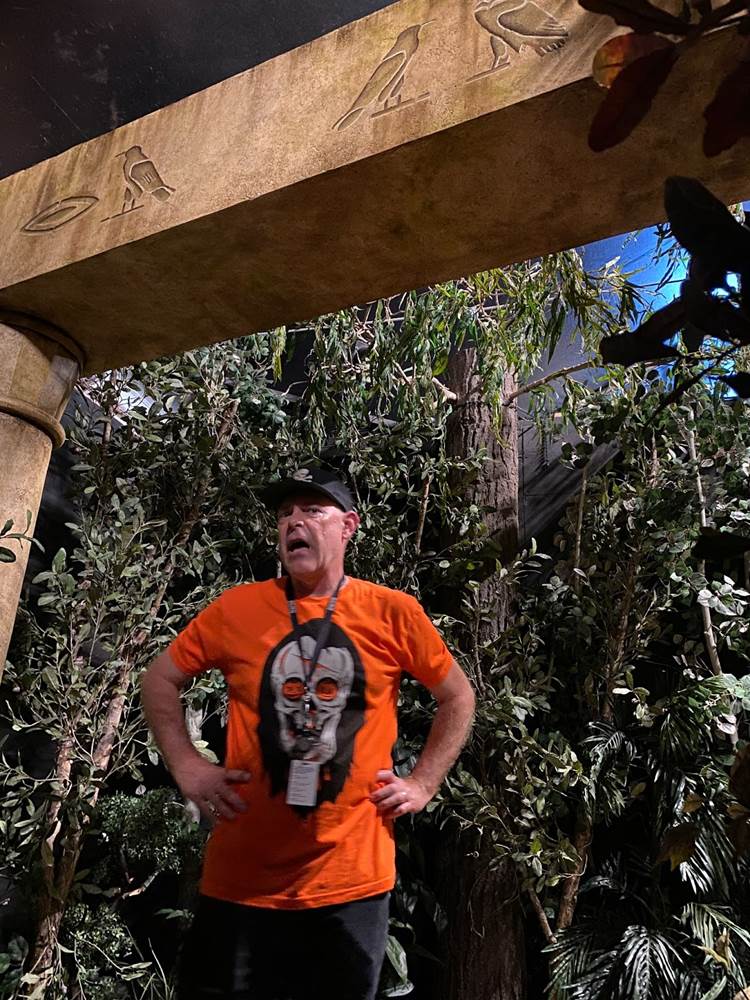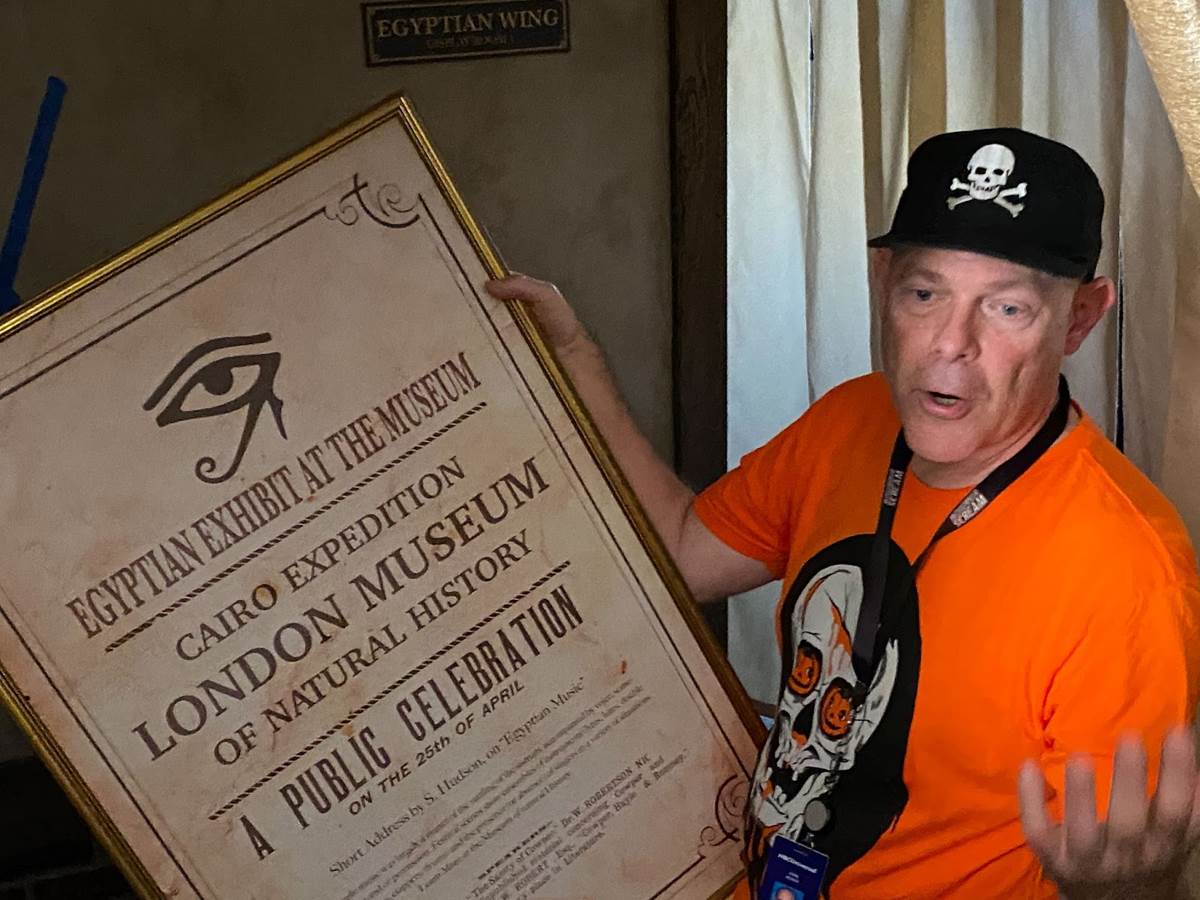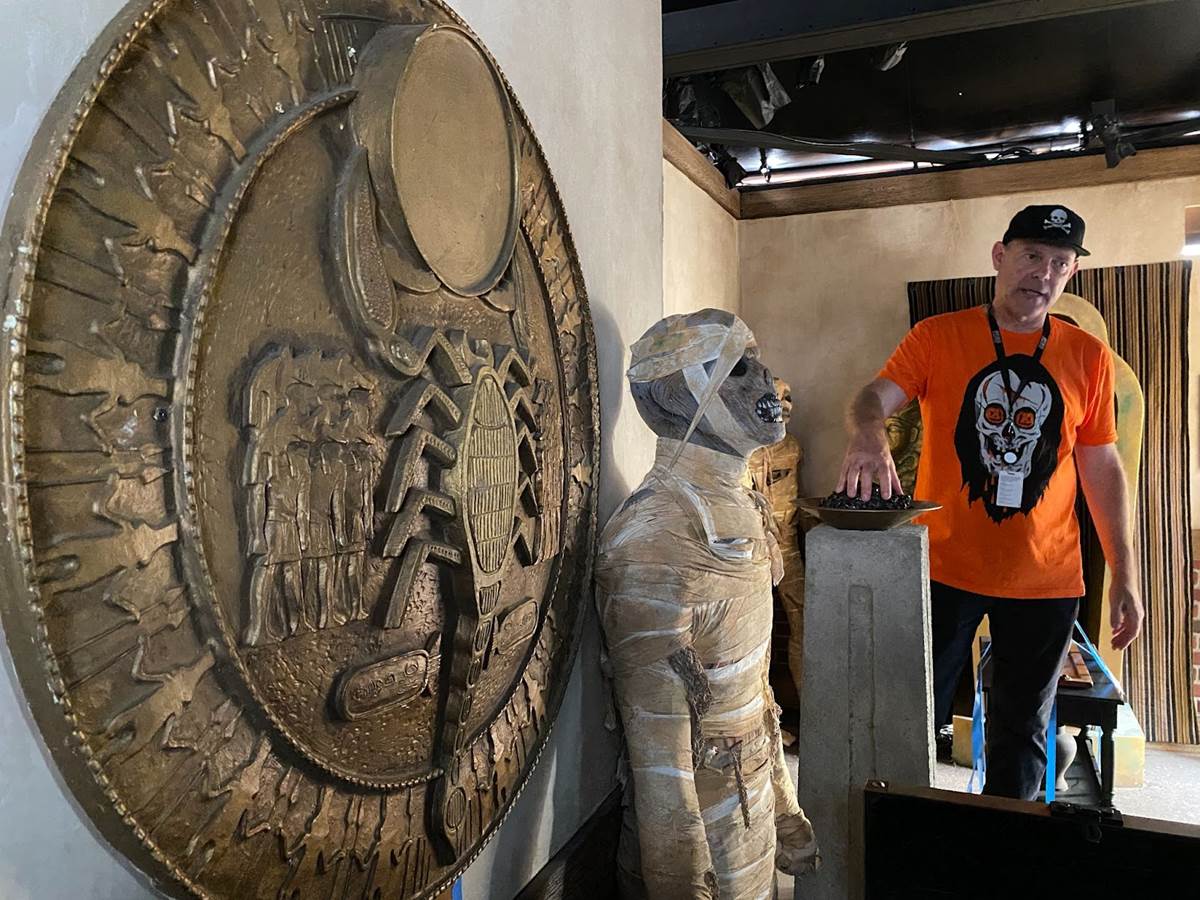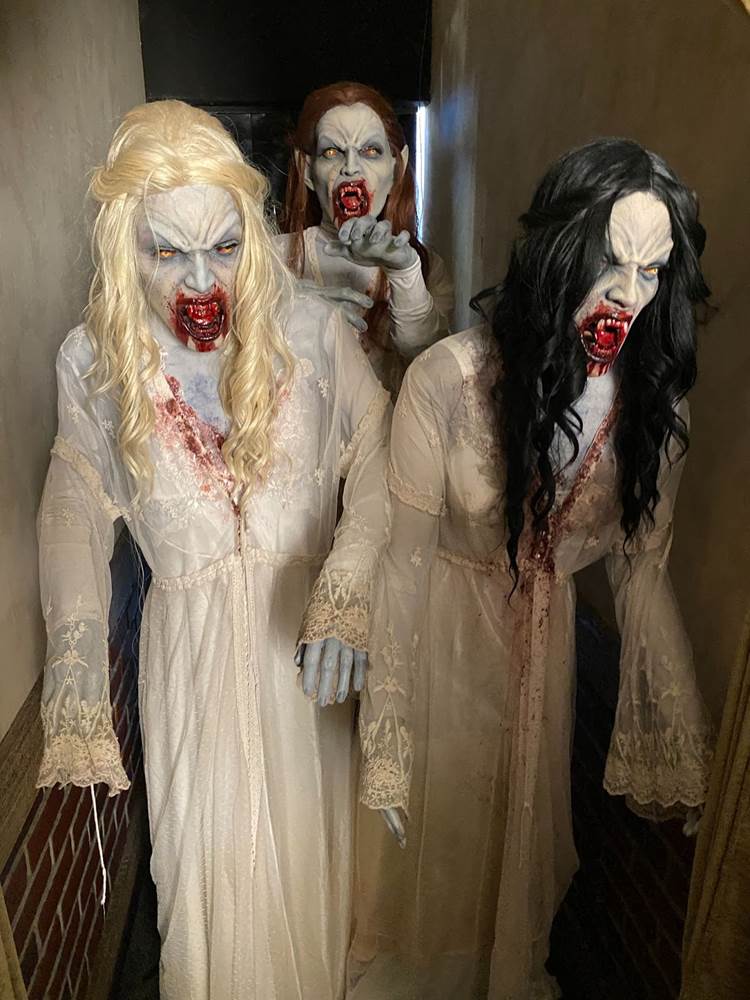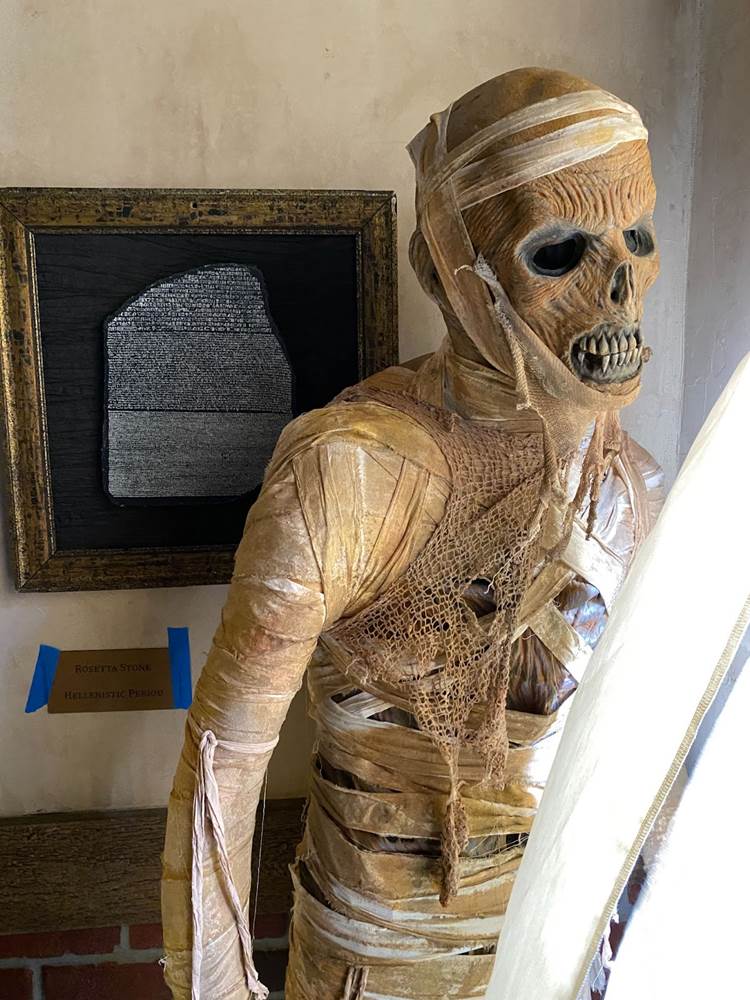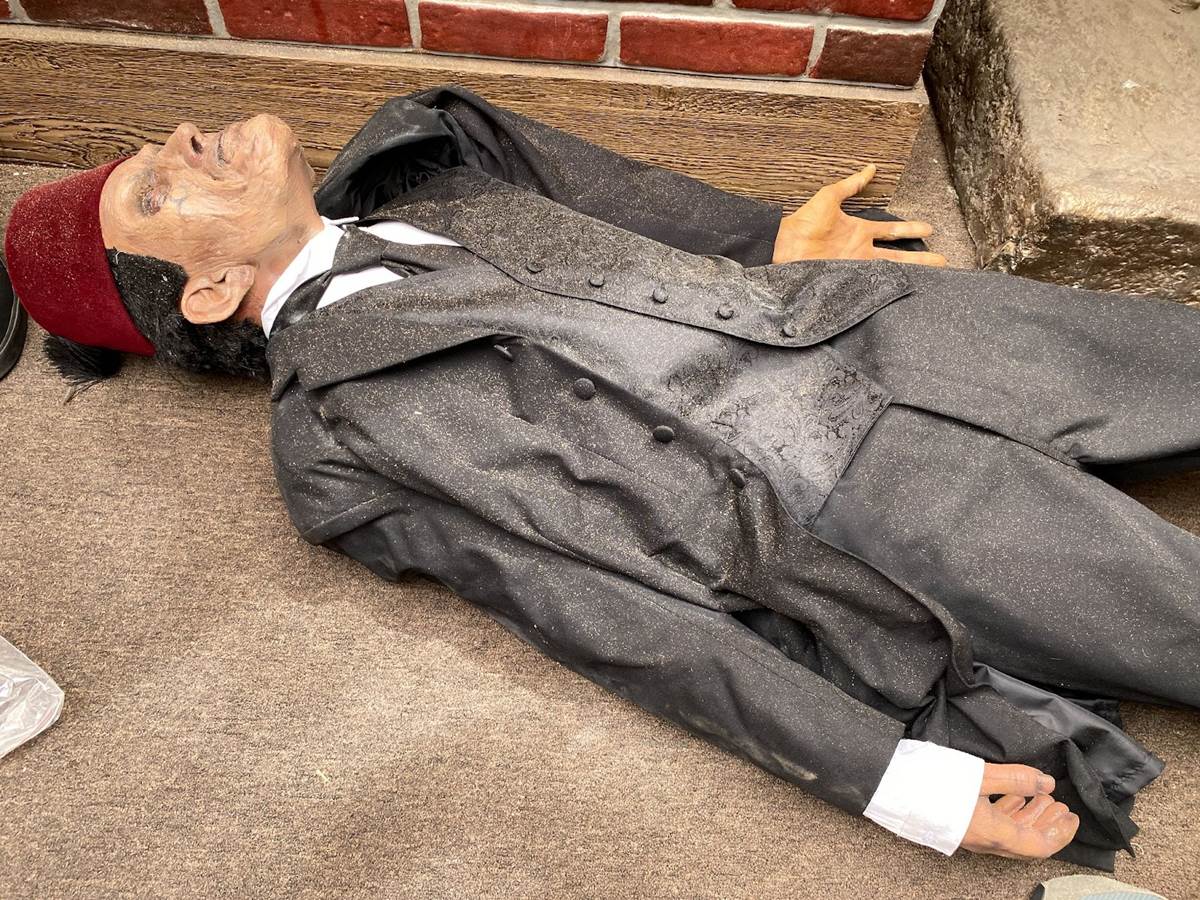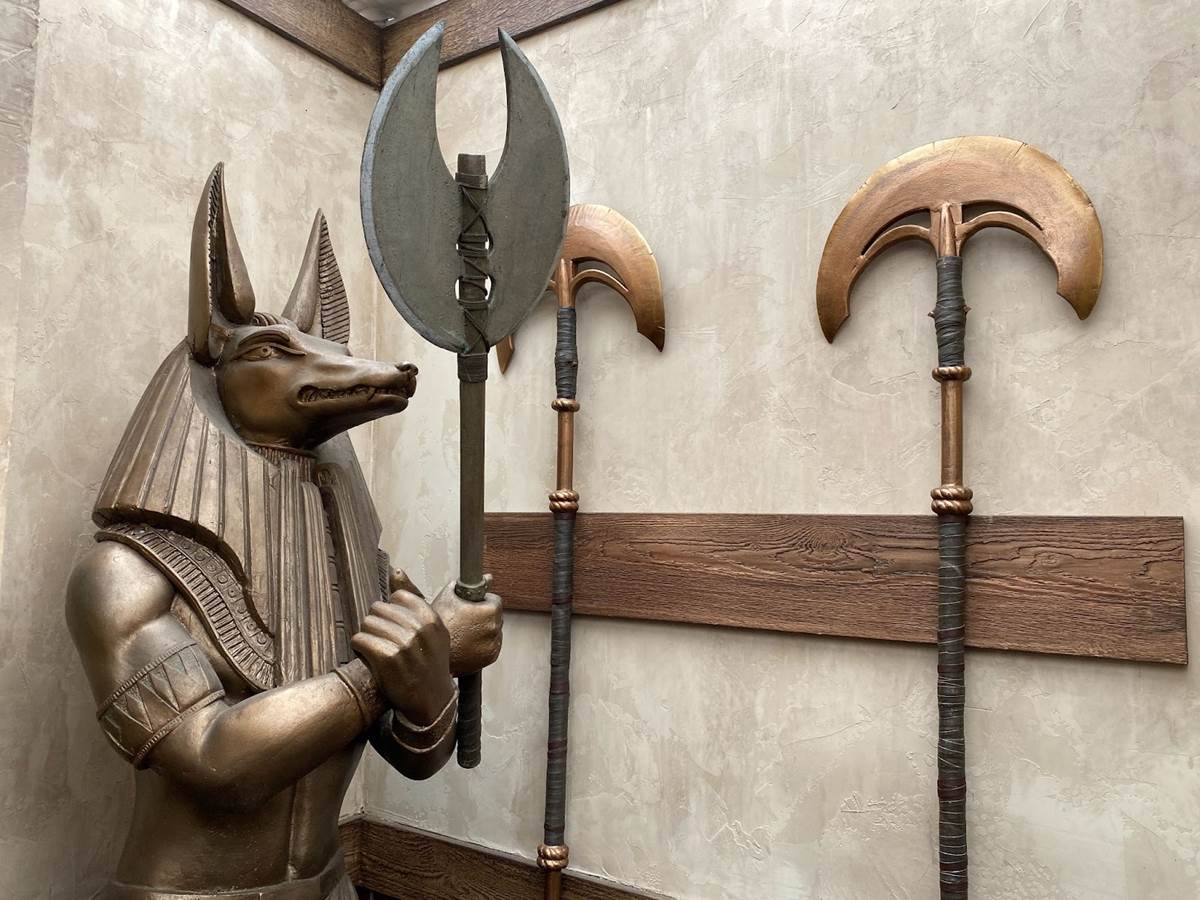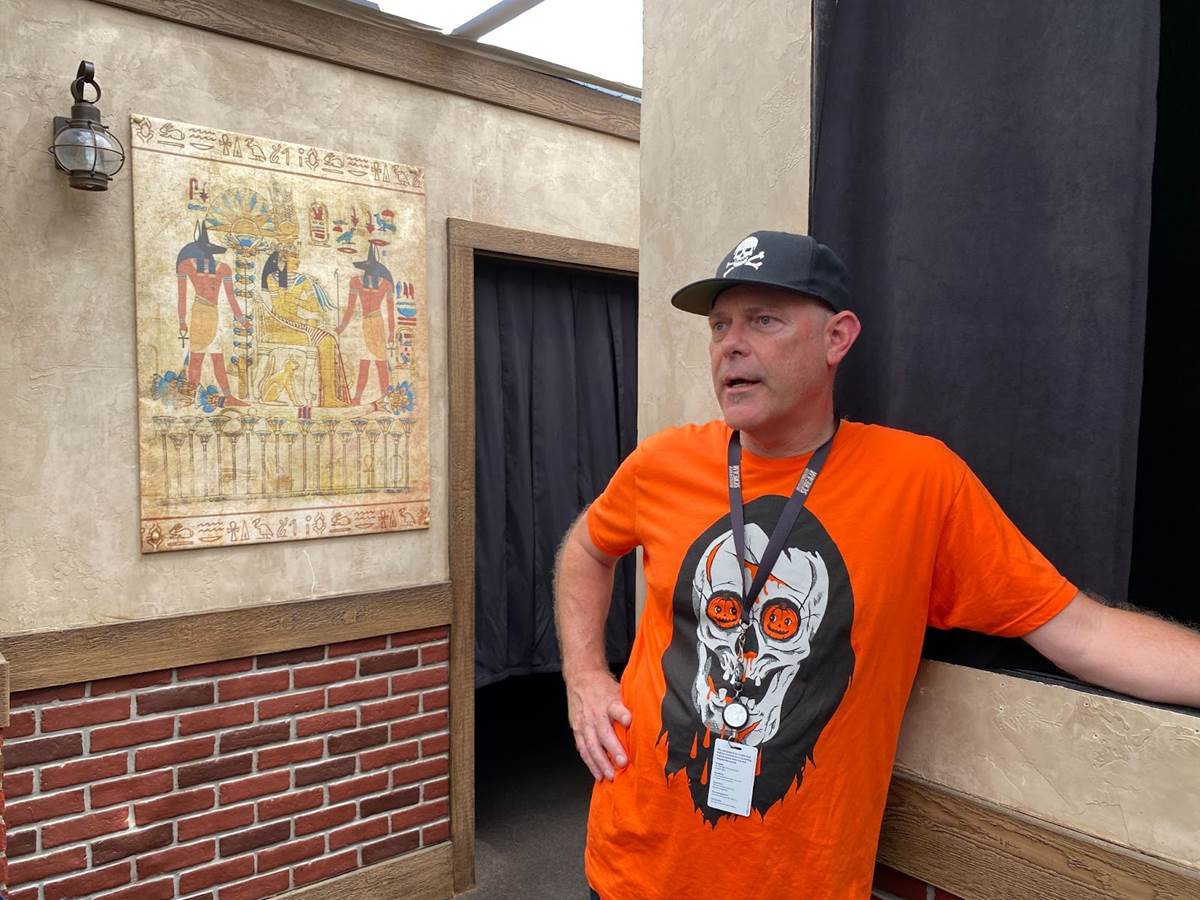John Murdy has been working as the Creative Director of Universal Studios Hollywood’s enduringly popular Halloween Horror Nights haunt event since 2006, after serving as a Show Writer for projects like the Revenge of the Mummy attraction and the reimagining of the theme park’s world-famous Studio Tour.
As part of a media tour, I recently had the opportunity to walk through the “Universal Monsters: Legends Collide” haunted house at Universal Studios Hollywood with John Murdy as our guide as he prepares for this year’s highly anticipated iteration of Halloween Horror Nights.
“I was doing research on this house and I found this building,” began Murdy at the start of our tour. “This is [a replica of] a real building that’s from the Limehouse district of London along the Thames. This [story] takes place in late-Victorian London, and in that era, London– particularly the area around the docks– was like Amazon, basically. Every good that was going anywhere in the world came and passed through those ports. And the reason we selected this as the facade and London as the setting is because it’s already in the story of these films. In the 1931 Dracula with Bela Lugosi, after he meets Renfield and they enact their real-estate transaction in Transylvania, the action all moves to London. The same thing [happens] with The Mummy– one of the very first shots in the 1932 Mummy film is the shot of the archaeological base camp, and it’s being sponsored by the British Museum. Back in those days, England took everything from all around the world and they brought them to London. So that gave us the idea of if they were doing an expedition in Egypt, they would most likely try to bring what they found back to London. Then lastly, it’s the wolfman himself. He’s from the UK; his ancestral estate is in Wales. We wanted to bring these three characters together. We needed a reason to bring them together, and what we decided was the common thread between these three characters was the idea of curses.”
“All three of these characters are cursed in different ways. The Mummy is quite literally cursed when he is caught in the temple with the princess and put to death in that horrible way where he’s mummified alive and buried in his sarcophagus, this curse is placed upon his very tomb. Dracula gets to live forever, but he can’t go out in the daylight. Imagine how productive Dracula would be if he could feed day and night. And then the wolfman is cursed by the cycles of the moon– every time the moon is full he turns into this horrible beast and he kills people. So they’re all searching for some way to end this curse.”
“How we connected it to Egypt is in recent years, Egyptologists have discovered that Anubis– which is the jackal-headed figure you always see– they realized that that was improperly translated. He isn’t actually a dog-headed deity; he is a wolf-headed deity. That made us go, ‘Oh, he’s a wolf and a man. That’s interesting.’ So I collaborated with our colleagues in Orlando on this, because we were both going to be doing a Universal Monsters house. We both agreed early on that it was gonna be Mummy, Wolfman, and Dracula. And we had totally different opinions on what the settings should be.”
Charles Gray and Michael Aiello from Orlando were like, ‘We want to set it in an Egyptian tomb and make it all about the archaeological excavation,’ and we very much wanted to set it in London. So at a certain point in our meetings, we just went, ‘Well why don’t we do that? Why don’t we make it a two-part story? You guys tell part one, we’ll tell part two. They can stand alone on their own, but if anyone wants to go from Orlando to Hollywood or vice-versa, they can see two totally different stories with the same characters and the same overall arching plot.’ That’s what we did. Then we needed an object to focus [on]. There’s always an object in these Mummy movies: the Scroll of Thoth– it’s always something that the Mummy needs to be resurrected. So we came up with the idea of this burial amulet; we call it the Amulet of Amun-Ra, who’s pretty much the god of gods. His hieroglyph is a sun with a snake coiled around it. We took that idea, we turned the sun into a fire opal, we took the snake and we uncoiled him from the sun and made him two-headed, and then we set that against scarab beetle wings and made it a burial amulet. It’s both a costume piece the Mummy wears, but it’s also a special effect because it had LED technology to make it pulse like his heartbeat. And all of the monsters are after that.”
“If you notice, there’s a very large Easter Egg on the shipping warehouse. ‘Alucard’ is ‘Dracula’ spelled backwards. Dracula’s got money– he lives in that big castle in Transylvania, so he owns the shipping warehouse. He shipped his coffin back here, but through a series of circumstances, right when his coffin arrives, so does the Mummy’s sarcophagus, and so does the Wolfman, and it’s game on. To set up that story, we decided we actually needed a pre-show. So we created our own little video that’s gonna play while you’re waiting in line, and that's gonna set up this whole idea of curses and what brings these characters together– the Amulet of Amun-Ra. We sprinkled Easter Eggs throughout the whole thing– the symbol of Amun-Ra is stamped on these crates from Egypt, and then all the dockworkers are dead, so it’s just like the boat in Dracula. Some of them have puncture wounds on their necks. All of the things on the walls are historical maps of London from that time.”
“What we have in our production facility offsite is all of these statues– different props and dressing from Stephen Sommers movies: The Mummy Returns, The Mummy from 1999. They gave us all this stuff after the movie wrapped, because it was just gonna be destroyed. The vast majority of these have never been used for Horror Nights, because they’re just too big. We just don’t have room for them. But this time last year I was in our warehouse and I was like, ‘Oh yeah, we have all these statues. I’m definitely going to write something for this year that uses these.’”
“That meant we actually had to bring some of them in before we even built the walls, because they were so big. As you’re coming through this scene, suddenly Renfield appears in this window laughing, and as you turn the corner he slams the bang window. He’s the first character you encounter, and then you go into the holding room, which is the big scene with all the statues. All of this is screen-used from The Mummy movies. The Mummy’s sarcophagus has just arrived and been opened, so our Mummy performer is here. Opposite is Dracula’s coffin, so this is the first double-scare in the haunted house.”
“I wanted to do something that was similar to the briefcase in Pulp Fiction– I wanted this mysterious open chest that’s glowing with this otherworldly amber light. But in our case, we’re also making it pulse like the sound of a heartbeat, and that’s the Mummy’s heart. It’s the amulet that’s keeping the heart alive. There’s a couple times where you encounter this glowing chest as you go through the haunted house. The next room is the storage racks, where they’re organizing all the goods that are gonna get shipped from one place to the other, and [that’s where] we meet the next character. In a lot of this particular house, as far as the Mummy goes, I wanted to look more at the sequels. There’s plenty. [Universal] did a whole string of Mummy films in the 1940s– The Mummy’s Hand and The Mummy’s Ghost, etc. In all of those films, there’s always these guys called the High Priests of Karnak. They are the protectors of the Mummy, and they basically control him. They do that in our house with the Amulet of Ra, keeping his heart alive. So you’re going to run into the High Priests of Karnak as you go around the corner.”
“Then we take you to the paymaster’s office– this is where we introduce the Wolfman. Larry Talbot will be in the chair, mid-transformation. Unlike the other characters that are fully transformed which wear a mask, this is a full-blown prosthetic makeup [effect]. It takes about 90 minutes to get the performers into makeup, which is an eternity for Horror Nights. Hundreds of actors are getting into makeup every single night, but we pick certain characters– La Llorona’s another one– [to have in extensive prosthetic makeup]. All his bones are stretching and popping– it’s the painful, horrible agony of that, and he’s screaming and freaking out, and looking at his hands. A display [in the background] will be projecting the full moon. We wanted to do a fun thing with the moons in this house: every time it’s a scene featuring the Wolfman, it’s a pale blue moon. Every time it’s the Mummy, it’s a harvest moon, which is a golden amber color. And every time it’s Dracula, it’s a blood moon, so it’s like nature itself is reacting to this curse. The research I did for this, I actually pulled illustrations of Charles Dickens’s office in Victorian London, and then our props and dressing crew have to go out and source everything, create all these letters and documents, and then make sure everything’s attached. It’s a tremendous amount of work.”
“There are three major sections to this house– there’s the warehouse, there’s the graveyard, and then there’s the museum. Why a graveyard? Because for whatever reason, [in] every single Mummy sequel there’s always a graveyard scene. A lot of that has to do with what they did when they got around to the sequels. We think of our Universal Monsters films as these glorious films of the 1930s and 40s, which they are. The 30s films were at a certain level of production design that was really high, but when they got into the 40s and they started churning out these sequels, they were all ‘B’ movies, quite honestly. That’s what they were. They had much smaller budgets. You can tell in the Frankenstein films just by looking at the lab. When you look at the lab in Bride of Frankenstein, it’s this amazing, gorgeous, huge set they built in Stage 12, but by the time you get to House of Frankenstein, it’s a couple of moving lights and stuff they found in the prop warehouse. I think the reason that they had graveyards in all these Mummy movies is because they always move the action in these sequels to America for some reason. They didn’t want to go shoot location photography in Egypt, or they didn’t want to have to build Egyptian sets.”
“So we’re gonna take you out into the graveyard at night. Immediately you get attacked by the Wolfman fully transformed. There’s an Easter Egg to the director of Dracula [above the tomb]. There’s [also] a video effect that’s controlled by Dracula– when you’re approaching it’s a loop of bats flying inside this crypt, and then when he hits his trigger it causes them to coalesce and form the shape of Dracula. He opens his cape, and then when he closes it again he bursts into a bunch of bats. Then the Dracula live performer attacks you– it’s all setting it up as a distraction. This is also a really good example of the work of our greenery department that does all the foliage, trees, and dead vines. The same people have been doing it since the beginning. What they’re trying to do is create a canopy that we can light, so when you go through here at night the walls disappear, everything disappears and you feel like you’re out in the woods or in a cemetery at night. It’s pretty amazing. For inspiration on this section, I did research on Highgate Cemetery, which is in London. It was built around Victorian times, and at that time all of England was on fire about anything Egypt, because they were making those early discoveries in the Valley of the Kings.”
“Highgate Cemetery actually has a whole Egyptian wing to it, so we wanted to pick up on that. As you turn the corner, it starts turning into Egyptian architecture, and we’re using invisible black-light paint and UV strobes to have other additional hieroglyphs and symbols appear. I meticulously researched all this stuff like I did for the Mummy ride. Every one of those hieroglyphs means something, and it’s all bad. It’s all, ‘You’re gonna die’ and stuff like that. Anubis, the god of death, comes in several times throughout this house until you get to the end.”
“And you’re hearing these freaky chanting voices, you go through a secret passageway in this tomb, and that takes you to the museum. The Mummy attacks you before you get there, and then you go into total darkness, which is an opportunity to do the classic effect I’ve been doing since I was ten years old: black industrial thread hanging in the path feels like cobwebs or something touching your face. It’s super simple, but it’s effective. You’re hearing the sound of flies buzzing around, but you’re also hearing the Wolfman as if he’s in there with you, stalking you. By the time you get to the end of the section, you get attacked by him again.”
“[Next] is the curator of the museum’s office. Unfortunately he has been murdered. Once again you hear Renfield’s laughter, he pops out from behind a door. [After] a big blast of thunder and lightning, Dracula appears in the windows. Then he opens the window and comes right out onto the desk, and then you take one step and the Vampire Brides come rushing in. This is our little cameo from “Bride of Frankenstein Lives” last year.
Slash from Guns N’ Roses is doing the entire score for this house, like he’s done for every one of our Universal Monster houses. This is the fifth collaboration between Slash and myself, going back to 2014. From here, we go into the first display room. The High Priest of Karnak that you saw earlier is standing over this flaming brazier, and he’s holding the Mummy’s heart that was in that case in his hand. He’s doing an incantation trying to bring all these mummies back to life, because his endgame is he wants to restore the old kingdom. It’s hard to find a good heart, prop-wise, because real hearts don’t look the way people think they look. My brother’s a cardiologist, so he sent me a good 3D model of a human heart. It has wireless technology so it pulses with the sound of the Mummy’s heart. And then our Mummy live performer comes to life.”
After the tour, I asked John Murdy how he felt about the excitement from fans surrounding the Universal Monsters-themed haunted houses whenever they’re announced, as opposed to more current intellectual properties. “I am so happy about that,” Murdy responded. “Because that was my greatest fear. In all honesty, I intentionally resisted doing anything with the Universal Monsters, even though it is by far my greatest passion in the world of movies in general. I grew up on those films. I’ve been a fan of those films for over 50 years. I have a massive collection of Universal Monsters memorabilia in my house, and I’m very precious with them. I’m a purist. I don’t like anything messing with the traditional classic films– just my personal taste. Monsters Remix is about as close as we got, but that was a total goof. That wasn’t really a serious attempt at taking on these characters. In 2018, when we were asked, ‘Can you do something with the Universal Monsters?’ I was really worried about it. I remember talking it over with my wife at the time, who knows my obsession with these characters, and she was like, ‘Don’t do it. It’s gonna break your heart, because it’s not gonna succeed.’ She was dead set like, ‘These kids aren’t gonna be into movies from nearly 100 years ago.’”
That was the worst thing to say to me, because then I was like, ‘I’m going to do it! I’m going to make it work!’ I got on this crazy rampage about [finding] a way to make this work, but we’re gonna do it with respect. The main design mandate from the beginning was, ‘I want to start with what’s iconic– if it was Frankenstein, it’s the flat head and the bolts in the neck– all the things that are iconic about these characters, and then we’re gonna go back into their stories and we’re gonna find what’s truly horrific, which there is in every case. Dracula lives on human blood, you know? And we’re gonna find a way to tease that to the surface so it can visually show in the masks, but still be iconic and still be instantly recognizable. You should be able to look at any of these characters and go, ‘Oh, that’s Dracula.’ And find ways to make them relate to a modern-day horror audience. Dracula’s a good example– my analogy for him is he’s a meth addict. Not literally, but he’s addicted to blood. He has to have blood. He’s just like an addict. Addicts show their addiction on their face, [so] if you look closely at our Dracula mask, you’ll see all the little veins have come to the surface in his face. It’s the same way for all of these characters. That’s the way we approached them.”
“Then 2018 came, and it was the #1 rated thing that we did that year by our fans. When all is said and done and I’m long gone, that’s going to be the thing that I’m the most proud of from Horror Nights. Somehow we took the Universal Monsters and made them relevant to a modern-day horror audience. And now they’re anticipating it, which is fabulous. So yeah, I’m really pleased that our fanbase is obsessed with them, because I want to turn that generation onto these films and keep them alive. They’re great films. They still hold up. They’re different– they’re not gonna scare anybody the way they did in 1931, but in our universe we’re definitely carrying that torch. It’s really cool. I’m really pleased.”
Halloween Horror Nights runs on select nights from Thursday, September 8th through Monday, October 31st. For additional details about the event and to purchase advance tickets, be sure to visit the official Universal Studios Hollywood website.
no obligation quote from MouseFanTravel.com

